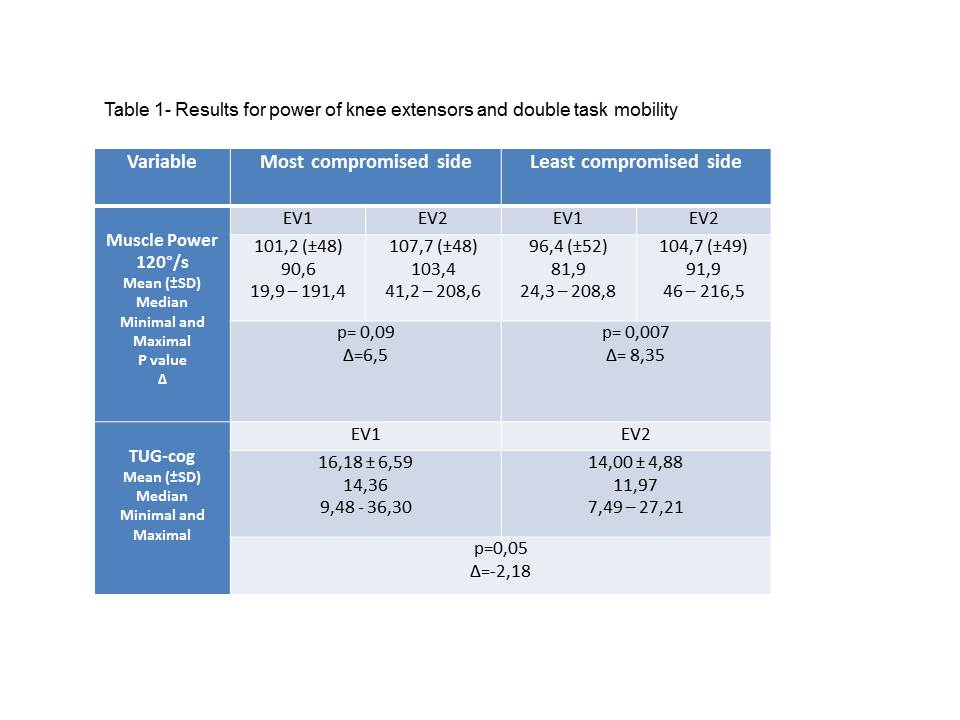Objective: Verify the effects of multicomponent aquatic exercise on muscle power and dual task mobility in persons with PD.
Background: Parkinson’s disease (PD) outcomes include changes in muscle and cognitive functions, where dual task becomes harder. Aquatic physical exercises are recommended for PD as they provide a safe environment for training and offers the physical and thermal benefits of heated water.
Method: Quasi-experimental, quantitative, blind observer, allocated for convenience, approved by Ethics Committee of the Federal University of Paraná, Curitiba, Paraná, Brazil (CAAE 66781417400000102, n. 2200372), respecting Resolution 466/12 of National Health Council. In the assessment (EV1) the individuals were classified as per Hoehn & Yahr scale (HY). Muscle power was assessed using Biodex® System, in the concentric/concentric isokinetic mode of knee extensors (120°/s speed), and dual task mobility by naming fruits while performing Timed Up and Go Test (TUG-Cog). All individuals were reevaluated (EV2) after 12-week of intervention, with two weekly sessions of 50 minutes in a heated pool (33º C.) They performed exercises to gain muscle function, functional mobility and balance, based on Israel’s five phases for motor learning. Normality was verified by Shapiro-Wilk test. Descriptive statistics for nonparametric results are shown. Variables were compared by Wilcoxon test using SPSS 20.0 software with a value of p <0.05.
Results: 18 participants, 11 (61.1%) male and 7 (38.9%) female, mean age of 66.72 ± 11.76 years. On the HY, 8 persons were between stage 1 and 2 (44.44%) and 10 between 3 and 4 (55.56%). Muscle power improved (p=0.007, Δ=8.35) on the most compromised side in EV2. There was also improvement (p=0.05, Δ=-2.18) in the TUG-cog (Table 1 – Results for power of knee extensors and double task mobility).
Conclusion: Conclusions: The exercise program improved muscle power on the side most affected by PD balanced it bilaterally. Execution time for dual task TUG improved, which may indicate impact in cognitive function. Thus, the exercise program was able to modify the muscular function and dual task mobility of the participants1,2.
Funding acknowledgements: This study was partially financed by Coordenação de Aperfeiçoamento de Pessoal de Nível Superior (CAPES), Finance Code 001.
References: 1 CUGUSI , L., MANCA, A., BERGAMIN, M., DI BLASIO , A., MONTICONE, M., DERIU, F., MERCURO, G.. Aquatic exercise improves motor impairments in people with Parkinson’s disease, with similar or greater benefits than land-based exercise:a systematic review. Journal of Physiotherapy. V.65. P. 65–74. 2019. 2 DEMONCEAU, M. et al.. Effects of twelve weeks of aerobic or strength training in addition to standard care in Parkinson’s disease: a controlled study. European Journal of Physical and Rehabilitation Medicine. V.53.N.2. P.184-200. 2017.
To cite this abstract in AMA style:
J. Siega, D. Iucksch, A. Silva, V. Israel. Hydrotherapy improves knees muscle power and dual task skills in Parkinson’s disease [abstract]. Mov Disord. 2021; 36 (suppl 1). https://www.mdsabstracts.org/abstract/hydrotherapy-improves-knees-muscle-power-and-dual-task-skills-in-parkinsons-disease/. Accessed April 3, 2025.« Back to MDS Virtual Congress 2021
MDS Abstracts - https://www.mdsabstracts.org/abstract/hydrotherapy-improves-knees-muscle-power-and-dual-task-skills-in-parkinsons-disease/

